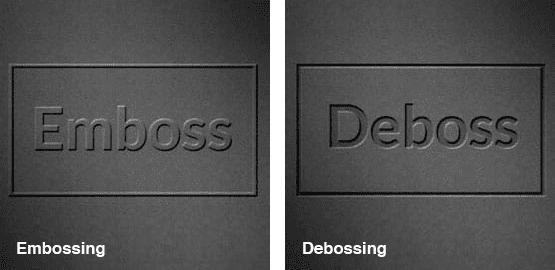Embossing and Debossing
Embossing is applied to selected areas of paper to create a raised shape or image. The embossed area becomes 3 dimensional providing a tactile and visual contrast against the flatness of the rest of the sheet.
Embossing is typically used where a high end, bespoke look is desired, e.g, wedding stationery, letterheads, folders, certificates, packaging etc. It is also useful as a security aid against counterfeiting.

How is embossing applied
The paper is placed between 2 metal magnesium or copper dies. The die underneath the paper will contain the raised pattern and the die on top of the paper (the counter die) will have a recessed version of the same pattern. The 2 dies are then pressed together using both heat and pressure forcing the paper into the recessed die, thus causing the paper fibre to be squeezed to create the permanently embossed area.
Types of embossing
Blind Embossing
Blind embossing is used to describe a raised but unprinted area. This provides a noticeable but subtle contrast without the use of any ink or foil and is able to cope with fairly small detail.
Registered Embossing
This is when the embossing is used in conjunction with print, foil or spot UV varnish (or a combination of more than one of these). A second embossed area can also be used to provide even more contrast.
Combination Embossing
An image is printed, foiled or applied in spot UV and the embossing is aligned to the image so that the printed image is stamped out. This method is particularly suited to text and simple images.
Debossing
Debossing is exactly the same process as embossing, except that the metal dies are transposed so that the area is stamped into the paper and forms a recessed (dented) area.
Just like embossing you can have the area plain and unprinted with just the debossed effect, or you can fill the area with ink or foiling.
